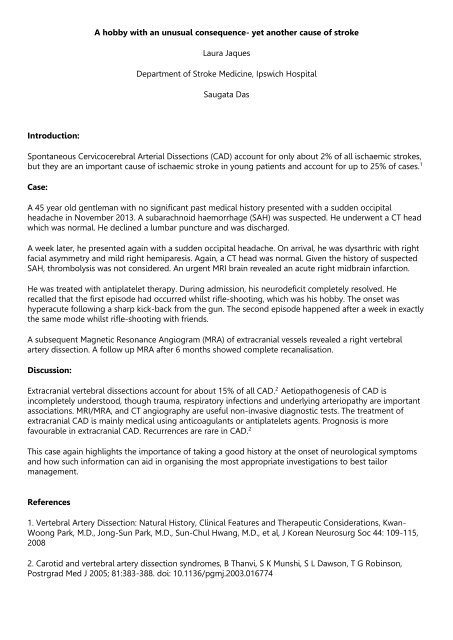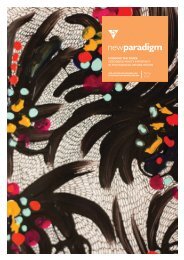Case Report ABSTRACTS
Case-Report-Abstracts
Case-Report-Abstracts
Create successful ePaper yourself
Turn your PDF publications into a flip-book with our unique Google optimized e-Paper software.
A hobby with an unusual consequence- yet another cause of stroke<br />
Laura Jaques<br />
Department of Stroke Medicine, Ipswich Hospital<br />
Saugata Das<br />
Introduction:<br />
Spontaneous Cervicocerebral Arterial Dissections (CAD) account for only about 2% of all ischaemic strokes,<br />
but they are an important cause of ischaemic stroke in young patients and account for up to 25% of cases. 1<br />
<strong>Case</strong>:<br />
A 45 year old gentleman with no significant past medical history presented with a sudden occipital<br />
headache in November 2013. A subarachnoid haemorrhage (SAH) was suspected. He underwent a CT head<br />
which was normal. He declined a lumbar puncture and was discharged.<br />
A week later, he presented again with a sudden occipital headache. On arrival, he was dysarthric with right<br />
facial asymmetry and mild right hemiparesis. Again, a CT head was normal. Given the history of suspected<br />
SAH, thrombolysis was not considered. An urgent MRI brain revealed an acute right midbrain infarction.<br />
He was treated with antiplatelet therapy. During admission, his neurodeficit completely resolved. He<br />
recalled that the first episode had occurred whilst rifle-shooting, which was his hobby. The onset was<br />
hyperacute following a sharp kick-back from the gun. The second episode happened after a week in exactly<br />
the same mode whilst rifle-shooting with friends.<br />
A subsequent Magnetic Resonance Angiogram (MRA) of extracranial vessels revealed a right vertebral<br />
artery dissection. A follow up MRA after 6 months showed complete recanalisation.<br />
Discussion:<br />
Extracranial vertebral dissections account for about 15% of all CAD. 2 Aetiopathogenesis of CAD is<br />
incompletely understood, though trauma, respiratory infections and underlying arteriopathy are important<br />
associations. MRI/MRA, and CT angiography are useful non-invasive diagnostic tests. The treatment of<br />
extracranial CAD is mainly medical using anticoagulants or antiplatelets agents. Prognosis is more<br />
favourable in extracranial CAD. Recurrences are rare in CAD. 2<br />
This case again highlights the importance of taking a good history at the onset of neurological symptoms<br />
and how such information can aid in organising the most appropriate investigations to best tailor<br />
management.<br />
References<br />
1. Vertebral Artery Dissection: Natural History, Clinical Features and Therapeutic Considerations, Kwan-<br />
Woong Park, M.D., Jong-Sun Park, M.D., Sun-Chul Hwang, M.D., et al, J Korean Neurosurg Soc 44: 109-115,<br />
2008<br />
2. Carotid and vertebral artery dissection syndromes, B Thanvi, S K Munshi, S L Dawson, T G Robinson,<br />
Postrgrad Med J 2005; 81:383-388. doi: 10.1136/pgmj.2003.016774




